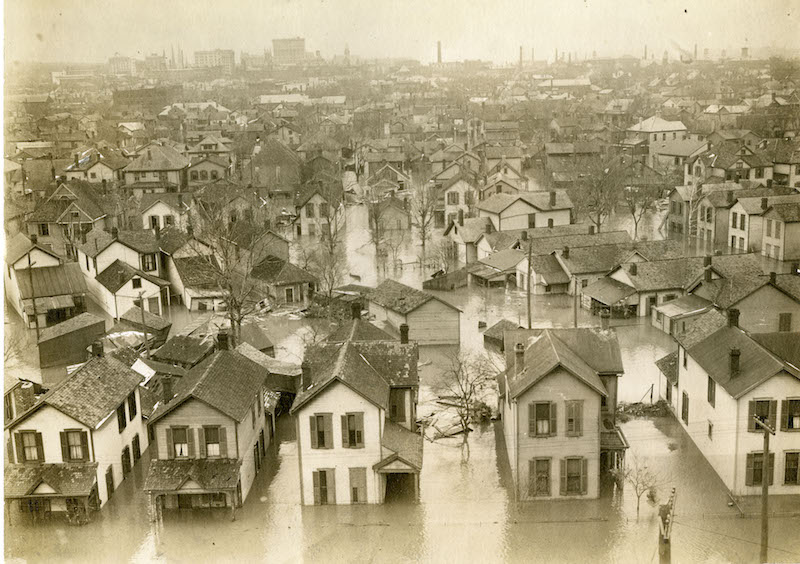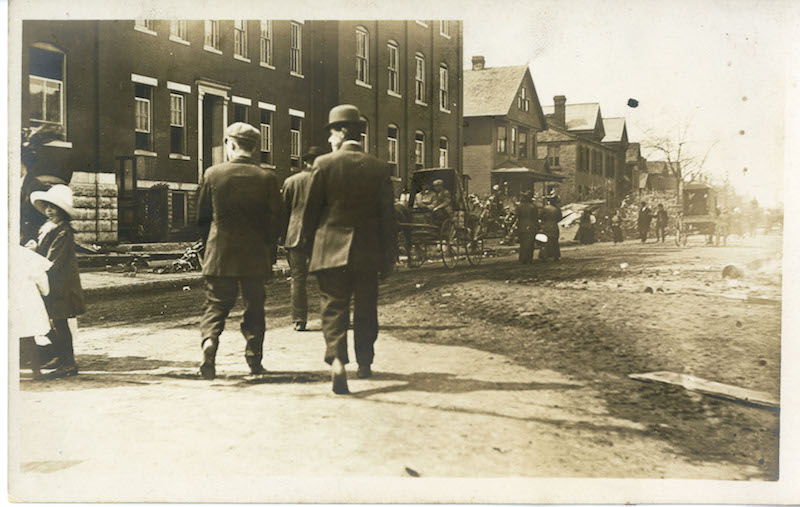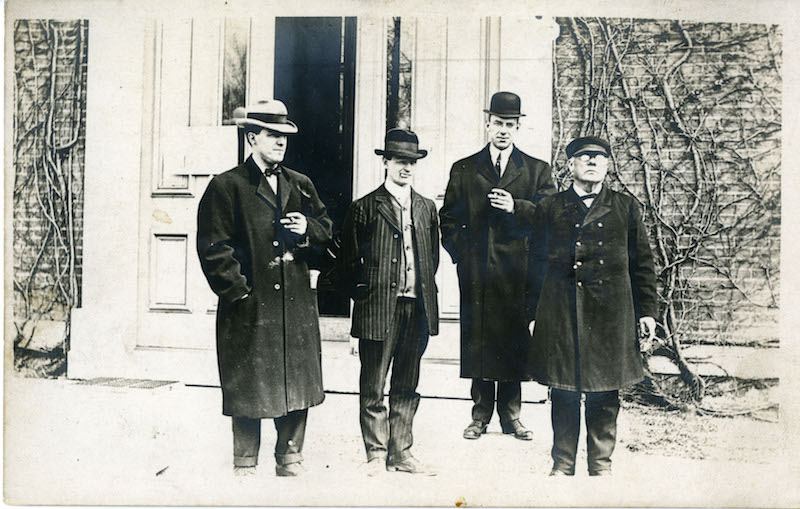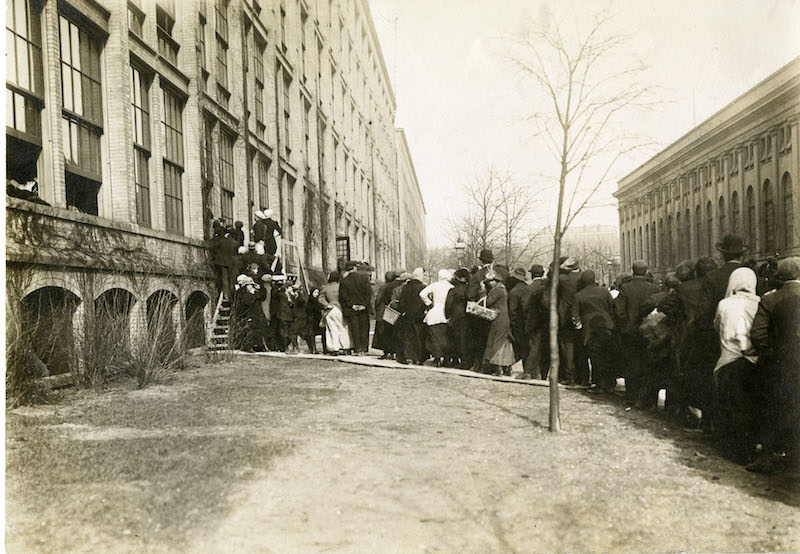University Libraries

Dayton Strong, 1913: Flood Response Brought Hope to Heartache
By Diane Osman
Our community is “Dayton Strong” — a phrase that echoed during the summer of 2019. It speaks to disaster, perseverance, and heroism as a grief-stricken city banded together to rise above adversity from a natural disaster and a mass shooting.
As the 108th anniversary of the Dayton flood of 1913 approaches in late March, the University Libraries look back at one of the greatest natural disasters in Ohio in the 20th century and recognize that a sense of community and a will to overcome hardship are embedded in the city’s history.
A bustling city
In 1913, Dayton was a bustling city of 117,000 residents — the 43rd-largest city in the nation. The city had a history of flooding, as it was built in a natural flood plain of four rivers — the Great Miami River, the Mad River, the Stillwater River and Wolf Creek. The city’s position seemed advantageous when it was founded in 1796, as it depended on rivers for water and transportation. Prior to 1913, the Dayton area had suffered major floods in 1805, 1828, 1847, 1866 and 1898.
On Good Friday, March 21, 1913, the flood’s first storm hit Dayton with winds up to 58 mph, knocking out telegraph lines. The rains continued past Easter Sunday, pounding the soil — already saturated from melted ice and snow — with 8 to 11 inches of rain over a five-day period. Runoff waters invaded the flood plain in massive force.
‘Like a tidal wave’
On Monday morning, March 25, Minnie E. Althoff, a librarian at the Dayton Public Library already at work with several other employees at the time, wrote in an account:
- “We flew to the shelves, lifting books, supplies and catalogue trays to the top rows wherever there was space, working with all possible speed each at different rooms. Soon I noticed water running along the floor and started for the stairs, when suddenly there was a terrific noise; the east doors and windows were thrown violently open and a great surge of black muddy water rushed in like a tidal wave upon us. I screamed for Miss Walter and Mr. Harvey and made a dash for the stairway. Mr. Harvey was caught in the waves up to his waist, and only with the greatest difficulty succeeded in reaching the first floor. Miss Walter I did not see again … through the hours which followed, I was pursued by the thought that she had perished.”1
At the height of the flood, waters reached 20 feet, rushing in at 25 mph into downtown Dayton. The Great Miami River swelled to a width of more than a mile. Over 4 trillion gallons of water destroyed 20,000 homes, killed 1,400 horses, displaced 65,000 residents and resulted in the deaths of approximately 360 people. The region sustained $100 million in damages. For days, survivors of the flood were stranded in their attics or on their rooftops, praying to be rescued as gas explosions and fires burst all around them in the city.
The community responds
In the spirit of community, individuals and organizations came to the aid of the victims, risking their own lives. NCR founder, John H. Patterson organized his factory into a relief station and commissioned his carpentry department to make over 200 flat-bottomed boats for the rescue effort. Thousands of survivors received shelter, food, clothing and medical care; the NCR garage was converted into a temporary morgue.
Another aid station was set up by Brother Edward Gorman, S.M., at St. Mary’s College, now the University of Dayton, providing food and shelter to over 800 flood victims. In an interview on Feb. 25, 1958, Brother Andy Weber, S.M., recalled witnessing the flood: “From our dormitory windows, we could see some of the havoc that was caused by the rising waters.” He recalled that while a colleague, Brother Louis Garavano, S.M., had “some narrow escapes, he was instrumental in helping out the sisters at St. Elizabeth Hospital.”2
Charity TODAY; innovation for TOMORROW
In the aftermath of the flood, May 25-26, 1913, the people of Dayton gathered outside the Old Court House, raising over $2 million for survivor relief. People came together and helped each other to survive. Inventor, engineer and industrialist Col. Edward A. Deeds led the effort to create the Miami Conservancy District (MCD), and the Dayton Flood Prevention Committee commissioned the well-known engineer and drainage specialist Arthur Morgan to plan a flood control system. His intricate system of dams, levees and flood protection plains — dubbed “Morgan’s Folly” by many — is still today considered a national model for flood prevention. Many describe the flood of 1913 as a pivotal point in Dayton’s history. It spurred innovation and cooperation and cultivated resilience and character in Dayton’s residents.
Explore images, artifacts, publications
The 1913 Dayton Flood Collection in the University of Dayton Archives has a host of photographs and postcards depicting the aftermath of the flood, some of which are in eCommons, the University’s institutional repository. An issue of the Exponent, a student-run monthly publication, documented the students’ perspective of the flood and created a register of flood refugees who stayed at St. Mary’s College. The collection also includes original flood footage and oral history highlights from the Glenn R. Walters collection.
— Diane Osman works in the dean's office of the University Libraries.
Sources
1 McCarty, Mary. “100 Years Later: Dayton Forever Changed by the Great Flood of 1913.” Dayton Daily News, March 26, 2013. https://www.daytondailynews.com/news/100-years-later-dayton-forever-changed-the-great-flood-1913/8hvDbu3xdf3wqHrbS8Y1YM/
2 University of Dayton. “Brother Andy Weber's Account of the 1913 Dayton Flood.” Voices from the Flood, 1958. https://ecommons.udayton.edu/archives_flood/3/



